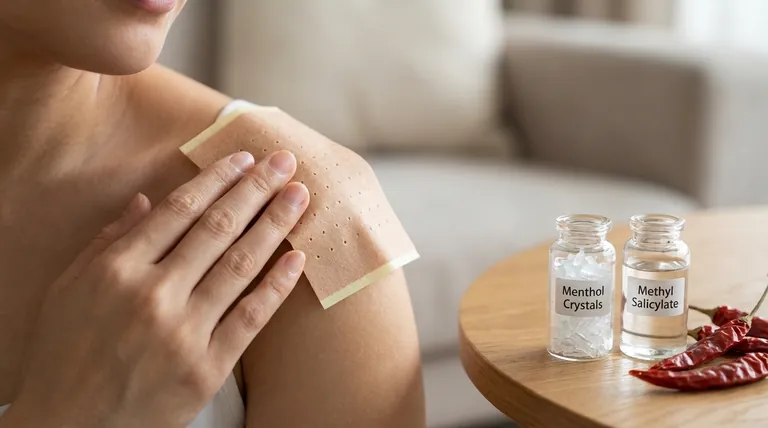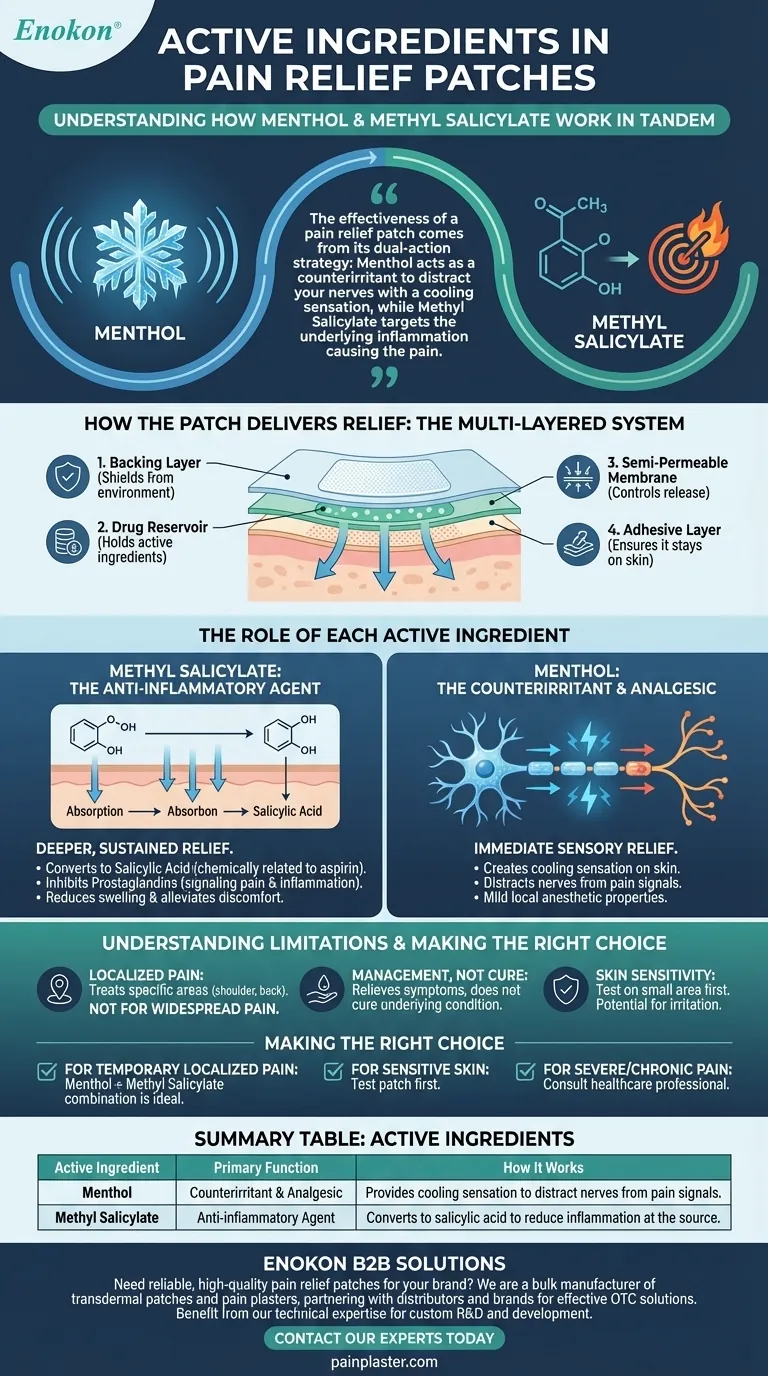The primary active ingredients in the typical pain relief patch are Menthol and Methyl Salicylate. These two compounds work in tandem, with one providing immediate sensory relief while the other works on a deeper level to reduce the biological markers of inflammation and pain.
The effectiveness of a pain relief patch comes from its dual-action strategy: Menthol acts as a counterirritant to distract your nerves with a cooling sensation, while Methyl Salicylate targets the underlying inflammation causing the pain.

How the Patch Delivers Relief
Before diving into the ingredients, it's helpful to understand the delivery system. The patch is not just a sticker; it's a sophisticated multi-layered tool designed for controlled release.
The Four-Layer System
A pain patch is typically composed of four key layers. An adhesive layer ensures it stays on your skin, while a protective backing layer shields it from the environment.
The Drug Reservoir and Membrane
The core of the patch is the drug reservoir, which holds the active ingredients. A semi-permeable membrane sits between the reservoir and your skin, carefully controlling the rate at which the medication is absorbed. This ensures a steady, consistent dose over time.
The Role of Each Active Ingredient
The two ingredients have distinct but complementary functions. They attack the problem of pain from two different angles.
Methyl Salicylate: The Anti-Inflammatory Agent
Methyl Salicylate is the component that provides deeper, more sustained relief. Once absorbed into the skin, it is converted into salicylic acid.
This is significant because salicylic acid is chemically related to aspirin. Its primary function is to inhibit the body's production of prostaglandins, which are compounds that are critical in signaling pain and inflammation. By blocking them, Methyl Salicylate helps reduce swelling and alleviate discomfort at its source.
Menthol: The Counterirritant and Analgesic
Menthol provides the more immediate sensation you feel when applying the patch. It acts as a counterirritant, creating a cooling sensation on the skin.
This sensation travels along the same nerve pathways as your pain signals. The cooling feeling effectively "distracts" your brain, making the underlying pain less noticeable. Menthol also has mild local anesthetic properties and helps suppress other inflammatory mediators, further contributing to pain relief.
Understanding the Limitations
While effective for their intended purpose, it's critical to understand what these patches can and cannot do.
For Localized, Not Systemic, Pain
These patches are designed to treat a specific, localized area, such as a sore shoulder, an aching back muscle, or a strained joint. They are not intended for widespread pain, like that associated with the flu, or for internal pain.
A Tool for Management, Not a Cure
A pain patch is excellent for managing the symptoms of muscle soreness, minor sprains, or arthritis. However, it does not cure the underlying condition causing the pain.
Potential for Skin Sensitivity
As with any product applied directly to the skin, there is a potential for irritation. The active ingredients or the adhesive can cause redness or discomfort in individuals with sensitive skin.
Making the Right Choice for Your Pain
To decide if this approach is right for you, consider the nature of your discomfort.
- If your primary focus is temporary relief from localized muscle or joint pain: The combination of immediate cooling from Menthol and deeper anti-inflammatory action from Methyl Salicylate is designed specifically for this purpose.
- If you have sensitive skin: It is always a good practice to test the patch on a small, discreet area of skin first to ensure you don't have an adverse reaction.
- If your pain is severe, chronic, or widespread: A topical patch is likely not the appropriate solution, and consulting with a healthcare professional is the best course of action.
Ultimately, understanding how these ingredients work empowers you to use this tool effectively for managing targeted pain.
Summary Table:
| Active Ingredient | Primary Function | How It Works |
|---|---|---|
| Menthol | Counterirritant & Analgesic | Provides a cooling sensation to distract nerves from pain signals. |
| Methyl Salicylate | Anti-inflammatory Agent | Converts to salicylic acid to reduce inflammation at the source. |
Need a reliable, high-quality pain relief patch for your brand?
At Enokon, we are a bulk manufacturer of reliable transdermal patches and pain plasters. We specialize in partnering with healthcare and pharmaceutical distributors and brands to deliver effective OTC solutions.
Benefit from our technical expertise for custom R&D and development. Whether you need a standard formulation or a custom patch tailored to your specific market needs, we have the experience to ensure consistent, controlled drug delivery.
Contact our experts today to discuss your pain relief patch requirements and discover how we can support your product development.
Visual Guide

Related Products
- Capsaicin Chili Medicated Pain Relief Patches
- Mugwort Wormwood Pain Relief Patch for Neck Pain
- Menthol Gel Pain Relief Patch
- Icy Hot Menthol Medicine Pain Relief Patch
- Lidocaine Hydrogel Pain Relief Patch for Pain Relief
People Also Ask
- How do pain relief patches work? A Guide to Targeted, Long-Lasting Pain Relief
- What precautions should be taken with buprenorphine patches? Ensure Safe Use and Avoid Overdose Risks
- Are natural and herbal pain relief patches effective and safe? Discover the Benefits of Targeted Relief
- Can pregnant women use pain relief patches? Your Essential Guide to Safe Pain Management
- What is the purpose of capsaicin patches? A Guide to Temporary Pain Relief
















